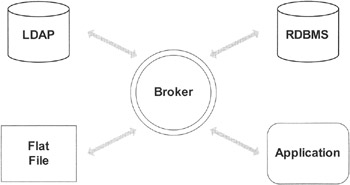Data Distribution between LDAP and Non-LDAP Systems
|
| < Day Day Up > |
|
What should you do if part of the data resides in non-LDAP systems, like relational databases, applications, or flat files? The first thing to consider is moving all of the data into one common LDAP repository. However, it is not always possible to migrate existing applications to another architecture. Nor is it always a good idea to convert everything into LDAP. There are many different factors that might hamper your efforts to move disparate data to a common repository. For example, an application might not be available in an LDAP-enabled version. Other reasons could be of a political nature. For example, a data "owner" might want to continue to maintain his repository using his familiar software without having to go through the enterprise directory to maintain the data. There are also cases where it is simply impossible for one reason or another to migrate the database to LDAP.
The most flexible way to create a common platform for all data sources is to design a broker that can put all the systems in contact, allowing you to maintain and query the data in a consistent way. Exhibit 19 shows an example of such a mixed-up environment.

Exhibit 19: Connecting Different Repositories
Broker
Before we look at commercial implementations, let us first have a brief look at the requirements for a broker connecting different repositories. These requirements depend very much on the particular implementation. As mentioned previously, the directory can be interconnected with a number of different repositories. Thus, the first thing to do is to understand the different repositories holding the data and the types of data they hold.
For each of the repositories (LDAP, RDBMS, application, flat file, etc.), you need to build a connector to regulate the data flow. This connector is specialized to keep a connection between the data source and the directory. As such, it has to know the direction of the data flow, i.e., it has to know which of the two partners is the master and which is the slave.
If both of the partners accept modifications, there must be a strategy module to decide which of the modifications should be kept in the event that both sources receive an update. The strategy module also has other jobs to do. A data source that accepts modifications is called a "data producer." There is usually more than one data producer. The strategy module therefore has to decide on a sequence for the different data producers so that they are synchronized with the directory. If two or more data producers can update the same data, there is a possibility of generating conflicting data. The strategy module has to be configured to resolve such conflicts. (The conflicts are the same as those that can occur with multimaster replication of LDAP servers.)
Conflicts are mostly a sign that there are problems in the data flow. A conflict indicates that there is more than one source responsible for the maintenance of the same data. In most cases, it is good to review the business logic that requires this redundant maintenance and find a solution of a master-slave relationship. We will discuss this further in Chapter 9 when we learn more about LDAP server design.
Security is another important consideration. You have to determine what types of user credentials should be used to pass information between different systems. You may also need to set up the exchange of certificates to allow conversing partners to verify each other's authenticity.
The broker centrally controls all of these connections and the data flow between the different repositories. The frequency of the update between the repositories is yet another important consideration. You need to define how much time it should take for the different repositories to become aligned. It is also important to decide which of the repositories should be considered as the authoritative data source.
It is not overly difficult to set up an environment connecting different repositories so that they can communicate with each other. However, as the saying goes, the devil is in the details. This means that the framework needs to be carefully designed and implemented. Needless to say, a home-grown implementation has the advantage of exactly meeting your particular application and security requirements. However, you will need the skills of people who can design, develop, and maintain the software. Most of the commercial directory servers offer a solution that sits on top of their directory server, a metadirectory. We will learn more about metadirectories in the next section.
Metadirectory
If you do not want to develop your own solution for data distribution, you can adopt a ready-to-use product called a "metadirectory." The function of a metadirectory is to synchronize a central directory with the different repositories on different systems. The way a commercial product performs this task is similar to the theoretical approach described in the previous section. One central strategy module (that can also be called a broker) looks around at the various repositories and tries to keep the central directory in sync with the repositories. The central strategy module can be configured to describe the locations of the various repositories, the update frequencies, the interrogation sequence for the different data sources, and the authoritative data source.
The number of vendors of metadirectory solutions is constantly growing. The major names are Siemens with its DirX 6.0 product, Sun One metadirectory, Microsoft metadirectory, and many others. Metadirectories are a relatively new area, and vendor brochures have created high customer expectations.
As previously noted, behind the problems a companywide metadirectory should solve, there are mostly organizational or design problems. The tool will not solve these problems. However, the tool may be helpful in uncovering these problems and may lead to a change in the business logic, thereby avoiding data inconsistencies.
|
| < Day Day Up > |
|
EAN: 2147483647
Pages: 149